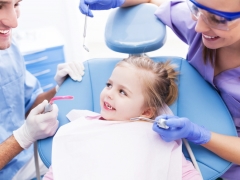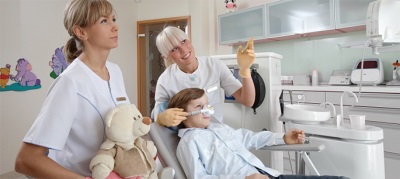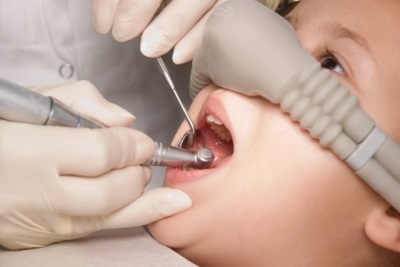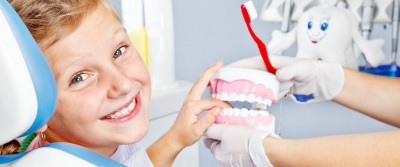The use of nitrous oxide in dentistry in dentistry in children
Dental treatment in a child often requires the use of anesthesia. One of the options to calm babies during unpleasant procedures is the use of nitrous oxide. Another name for this substance is "laughing gas." Can it be used for anesthesia in young children, isn’t the use of nitrous oxide harmful for a child’s body, and what side effects can this medication cause?
Benefits
- Used in low concentrations of nitrous oxide has a relaxing effect, similar to a slight intoxication. It is called sedation, because the patient’s consciousness is slightly inhibited, but the main reflexes are preserved. The child's pain decreases, and the stress associated with dental treatment is more easily tolerated. In this case, the baby can breathe, speak and move.
- The use of nitrous oxide soothes children who are afraid of dentists or very worried in the dentist's office. So that the experiences would not affect the results of the manipulations with the teeth, such treatment with sedation is resorted to. Parents will not need to hold the crumb by force.
- Due to the high-quality purification of nitrous oxide such the tool practically does not cause allergies and does not irritate the respiratory tract. This gas does not enter into any reactions inside the body (it is inert) and does not bind to hemoglobin. As soon as the supply has stopped, in 3-5 minutes nitrous oxide is completely removed from the body in the same form in which the gas entered the body. This makes this medication one of the safest drugs and allows the use of even the smallest children in the treatment.
- Treatment of children's teeth with nitrous oxide is in demand for hyperactivity of the child. The drug will make the baby more calm, and quite often causes drowsiness.
About how effective and safe this technique is, the dentist, Ph. M.N. Vladimir Leonidovich Aleksandrovsky.
disadvantages
- In some children, the use of nitrous oxide becomes cause headaches or dizziness.
- The gas has a rather sharp smell what may not please the child.
- Gas mixture can not be used with a cold and other problems with the upper respiratory tract, as well as with some other diseases.
- The cost of sedation is quite high.
- There are cases when the effect of nitrous oxide on a child is paradoxical. Instead of relaxing, the baby becomes agitated and behaves inadequately. Also, the medicine can cause vomiting.
- Since nitrous oxide has no analgesic effect, during treatment, additional use of local anesthesia is required.
Indications
Nitrous oxide is used in pediatric dentistry:
- At the first visit to the doctor, especially if the dental diseases are neglected and the child needs to do any painful manipulations. The use of sedation will help to avoid the fear of dental treatment in subsequent visits.
- When treating preschoolers, Since it is difficult for children of 3-5 years old to sit without moving in a chair for more than 15 minutes without nitrous oxide, and the use of the preparation allows teeth to be treated at that age by 40 minutes. As a result, the number of visits to the doctor is reduced.
Example, when it is impossible to do without the use of nitrous oxide in the treatment, see below:
Contraindications
Nitrous oxide sedation is not used for complex treatment, when it is necessary not only to relieve the child from pain and fear, but also to completely eliminate his reaction to external stimuli (doctor's manipulations).
Also, this gas mixture is not used:
- With colds, allergic rhinitis, sinusitis or adenoiditis if the disease interferes with normal nasal breathing.
- If it is impossible for a child to communicate with a doctor. For this reason, nitrous oxide does not recommend soothing babies under 3 years old, when a crumb can not tell about their condition.
- When recently traumatic brain injury (within three months before treatment).
- During exacerbation chronic otitis media.
- With convulsive syndrome or epilepsy.
- With a strong fear or panic attack.
How is nitrous oxide used
Before using the gas, children are told about the procedure, so that the baby sits in the dentist’s chair without objection and allows the procedure to be carried out. A mask is put on the child, from which the tubes go to the balloon filled with gas. Inside such a cylinder is not only well-purified nitrous oxide, but also oxygen with other impurities.
The doctor turns on a special device and the gas mixture begins to flow into the baby's nasal cavity. After gas inhalation for several minutes, the dentist may proceed with the examination or treatment. Cartoons are shown to the child at this time, and the mask does not prevent the doctor from carrying out any manipulations in the oral cavity.
Reviews
Dentists speak about the use of "laughing gas" in treating children mostly positively. According to doctors, such a drug really contributes to a better treatment of children's teeth and prevents the fear of the dental office in preschool children. Since the concentration of gas is low, and the drug itself is thoroughly cleaned, harm to the child’s body is maximally excluded.
Parents treat nitrous oxide in dentistry differently. Some mothers consider such a medicine as an excellent way out, others fear its harmful effects, others embarrass that the child is conscious during treatment. Because of these experiences, many mothers decide to abandon nitrous oxide in favor of general anesthesia. As for the cost of the procedure, the price of treatment with nitrous oxide is perceived by some parents as moderate and others as high.
For details on the use of nitrous oxide in dentistry, see the following video.














